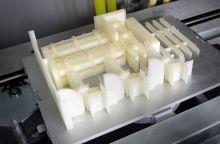If Don Quixote were alive today, he might be tilting at some 3D printed windmills. That is, if he traveled to Lubbock, Texas where WhiteClouds has teamed up with The American Wind Power Center (AWPC) to use computer aided design and 3D printing technologies to produce scale models of local historic windmills. The AWPC has over 100 windmills on display in their indoor gallery and a further 60 that have been built outside in the nearby Linebery Windmill Park. This landmark collection makes the AWPC the largest windmill museum in the world and quite a site for windmill enthusiasts.
The 3D printed windmills created through this partnership are to be part of a display in the AWPC museum featuring the Texas city of Lubbock as it was from 1910 to 1950. Coy Harris, Executive Director of the AWPC has been working closely with WhiteClouds’ designer Kelly Root to 3D print the scale models in their lab on a ProJet3500 HDMax. Harris said of the contribution made by 3D printing technology:
“By using 3D design and 3D printing [we] were able to get a scale model of a windmill that isn’t available anywhere else. This is a windmill that was being used over 30 years ago. Scale models of it simply aren’t available anywhere, it had to be created from scratch.”
 Multi-Jet Modeling technology has been used to print the windmill models. The process uses UV-cured resin to build up layers, each of which is only 16 microns in thickness. The diminutive nature of these layers, approximately the width of a human hair, allows for incredible detail and precision without sacrificing the durability of the plastic parts.
Multi-Jet Modeling technology has been used to print the windmill models. The process uses UV-cured resin to build up layers, each of which is only 16 microns in thickness. The diminutive nature of these layers, approximately the width of a human hair, allows for incredible detail and precision without sacrificing the durability of the plastic parts.
Each model is printed either translucent or off white and then assembled by Harris and his team. Rather than simply being a time saver, which this process undoubtedly is, 3D printing the model parts is an essential part of this project’s possibility. So, while there is hand assembly involved, and they will need to construct the wooden towers themselves, according to Harris, “most of the windmills are too complicated to hand build and that is why they are being printed.”
The techniques employed to recreate this windmills have been varied; ranging from modeling done based on reverse engineering scale models already in the AWPC’s collection to consulting old blue prints and photographs. The team noted that the most difficult aspect of the project was remaining true to the nature of the windmills while acknowledging the restraints and possibilities provided through 3D printing technology.
Could 3D Printing be used in conjunction with data from the past to reconstruct other models of older cities, and towns? Let’s hear your thoughts on Whiteclouds and AWPC’s use of this technology in the 3D printed historic windmill forum thread on 3DPB.com.
[Source: WhiteClouds]Subscribe to Our Email Newsletter
Stay up-to-date on all the latest news from the 3D printing industry and receive information and offers from third party vendors.
Print Services
Upload your 3D Models and get them printed quickly and efficiently.
You May Also Like
The Dental Additive Manufacturing Market Could Nearly Double by 2033, According to AM Research
According to an AM Research report from 2024, the medical device industry, specifically in dentistry, prosthetics, and audiology, is expected to see significant growth as these segments continue to benefit from...
Heating Up: 3D Systems’ Scott Green Discusses 3D Printing’s Potential in the Data Center Industry
The relentless rise of NVIDIA, the steadily increasing pledges of major private and public investments in national infrastructure projects around the world, and the general cultural obsession with AI have...
AM Research Webinar Explores Continuum’s Sustainable Metal Additive Manufacturing Powders
Metal additive manufacturing (AM) powder supplier Continuum Powders is working to develop solutions that empower industries to reduce waste and optimize their resources. An independent life cycle assessment (LCA) of...
3D Printed Footwear Startup Koobz Lands $7.2M in Seed Round
California-based Koobz is focused on reshoring the U.S. footwear supply chain with advanced manufacturing processes, including 3D printing. The startup just announced that it has added $6 million to its...


































